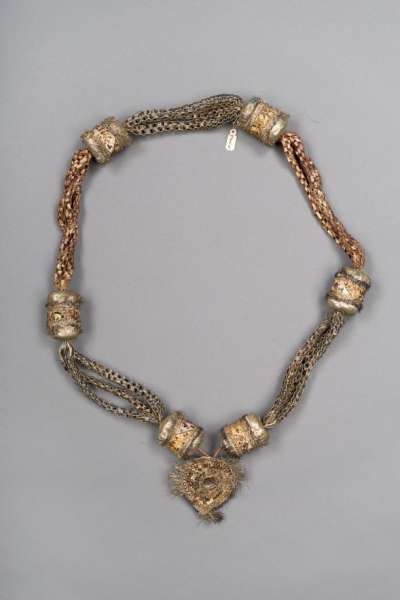Garland
Although, the three presentation garlands seen during the review do not fit into the above interpretative ideas, I would consider them one of the highlights of the personal ornament section. Their ephemeral nature means it is quite unusual to find older 19th century examples like these in museum collections. They are a huge part of the adornment process in India and I was particularly pleased to see these three examples in the collection.
Garlands like these are given as signs of welcome and hospitality to visitors by their hosts or are presented to the soon to be bride and groom at the start of the marriage ceremony. Their elaborate nature echoes the bejewelled depictions of the Hindu Gods and Goddess, projecting a sense of the divine onto the young couple and the guest (there are many Hindu stories relating to the Hindu Gods disguising themselves and receiving wonderful hospitality or terrible treatment from the strangers they asked for help, who in turn either received great benefits or terrible ends as a result, so there is a great sense of duty in India to treat guests with great honour).
9 / 1945 / 45 follows in a very similar but more elaborate style; again it is a wonderful example. The central leave-shaped medallion singles it out as a garland worn at a wedding, as decorating the medallion are a pair of fish, a Hindu and Buddhist symbol of fecundity, fertility and happiness.
There are a group of garland makers in Thanjavur in Tamil Nadu who make garlands that are remarkably similar to the 19th century example we have here. The main conundrum in all this is that these garland makers claim to only have begun this style in the 1950s. See Traditional Jewelry of India, pp.370-371.
Garlands like these are given as signs of welcome and hospitality to visitors by their hosts or are presented to the soon to be bride and groom at the start of the marriage ceremony. Their elaborate nature echoes the bejewelled depictions of the Hindu Gods and Goddess, projecting a sense of the divine onto the young couple and the guest (there are many Hindu stories relating to the Hindu Gods disguising themselves and receiving wonderful hospitality or terrible treatment from the strangers they asked for help, who in turn either received great benefits or terrible ends as a result, so there is a great sense of duty in India to treat guests with great honour).
9 / 1945 / 45 follows in a very similar but more elaborate style; again it is a wonderful example. The central leave-shaped medallion singles it out as a garland worn at a wedding, as decorating the medallion are a pair of fish, a Hindu and Buddhist symbol of fecundity, fertility and happiness.
There are a group of garland makers in Thanjavur in Tamil Nadu who make garlands that are remarkably similar to the 19th century example we have here. The main conundrum in all this is that these garland makers claim to only have begun this style in the 1950s. See Traditional Jewelry of India, pp.370-371.
Object Summary
- Accession Loan No.
- 9/1945/45
- Category
- Ethnography
- Collection Class
- Personal ornament
- Collection Area Region
- S
- Material
- metal
- Common Name
- garland
- Simple Name
- garland
- Production Country
- India
- Production Year High
- 1945


